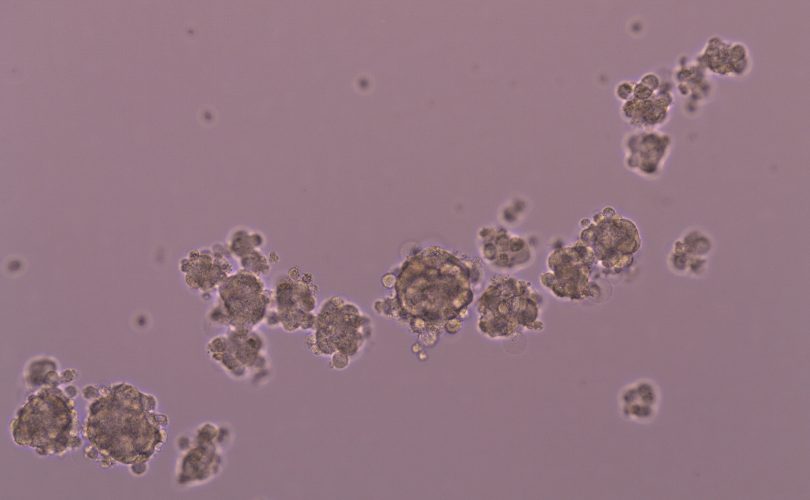What is Synovial Sarcoma?
Synovial sarcoma is a rare type of soft tissue sarcoma and is estimated to represent about 8% of all soft tissue sarcomas. About 1-3 persons in 1 million are diagnosed annually. It can affect people of any age, but is predominantly diagnosed in teens/young adults. It is also seen slightly more often in males than females.
Synovial sarcoma derives its name from its histologic (appearance of cells microscopically) resemblance to synovial cells. Its cell of origin is unknown, and it is thought that synovial sarcoma is not related to the synovial tissues of the joints. The current belief is that sarcomas do not arise from preexisting benign lesions, although it is commonly discovered after an injury to the affected area. The exact cause of synovial sarcoma is still unknown. However, there are identified predisposing factors such as genetic mutations, history of retinoblastoma, and previous exposure to chemotherapy/radiation therapy.
Diagnosis
Workup of the mass most often starts with imaging. This may include x-ray, CT, and/or MRI scans. The only way to confirm diagnosis of synovial sarcoma is to undergo a biopsy which requires a surgeon to obtain tissue samples for the pathologist to examine under a microscope. From the biopsy, the doctor will be able to tell you if the mass is synovial sarcoma. There are two morphologic subtypes: monophasic and biphasic. Monophasic tumors consist of only spindle cells, while biphasic tumors consist of spindle cells and epithelial cells. Both types of tumors are equally aggressive.

Symptoms & Effects
Synovial sarcoma is most commonly found near the joints of extremities (arms, legs). However, it can be found in other parts of the body such as the head, neck, and torso. Many patients will complain of a growing lump that may or may not be painful. Pain is often described to be persistent and unprovoked as it is most likely due to nerve involvement.
The common pattern of spreading (metastasis) is to the lungs. Therefore, patients with metastasis may also experience shortness of breath or a persistent cough. Synovial sarcoma may also spread to other parts of the body, including the brain, bone, local organs and lymph nodes.

Treatment
One of the main focuses of treatment is local control, which is usually achieved with surgical resection of the tumor. This means removing the whole tumor with a margin of healthy tissue, reducing the chance of local recurrence. In some cases, radiation therapy may also be used to reduce the chance of local recurrence, especially when clear margins were unable to be obtained due to the location of the tumor.
In cases of advanced or metastatic disease, chemotherapy may be recommended. Commonly used chemotherapeutic agents include Doxorubicin and/or Ifosfamide (also referred to as AIM). Given how rare synovial sarcoma is, there is no consensus on how much of a role chemotherapy plays in preventing metastasis and improving survival. Talk to your oncologist about the different regimens available and their side effects as you weigh the benefits against the risks.
Common Side Effects
Doxorubicin (IV drug)
Most common side effects:
- Pain along the site where the medication was given
- Nausea and/or vomiting
- Low blood counts which will put you at increased risk for infection, anemia, and/or bleeding
- Hair loss
Less common side effects:
- Red, red-brown, orange, or pink colored urine
- Problems with fertility
- Decreased heart function
Ifosfamide (IV drug)
Most common side effects:
- Low blood counts which will put you at increased risk for infection, anemia, and/or bleeding
- Hair loss
- Nausea and/or vomiting
- Blood in urine (hemorrhagic cystitis) which can be prevented by giving Mesna
Less common side effects:
- Central neurotoxicity (i.e., sleepiness, confusion, hallucinations)
- Problems with fertility
Further Workup
Oftentimes, cytogenetic analysis of the tumor will be performed. Synovial sarcoma is characterized by the chromosomal translocation, t(X; 18). This means that the SS18 gene on chromosome 18 switched locations to be next to or near one of the three SSX genes on the chromosome X: SSX1, SSX2, or SSX4. This results in a SS18-SSX fusion gene. This finding further confirms diagnosis of synovial sarcoma. The exact fusion type may also have prognostic significance as better outcomes have been reported for patients with SS18-SSX2 fusion type.
After a mass is identified to be cancerous, your doctor will most likely recommend further imaging to assess for metastasis. Due to the tendency for synovial sarcoma to spread to the lungs, an X-ray and/or CT chest scan may be done. Another imaging modality that is commonly used to look for metastasis is a PET scan, which is a whole body scan. If possible, find an oncologist who specializes in sarcoma. It is helpful if your doctor is at a cancer center with surgeons, radiation oncologists, and pathologists who also specialize in sarcoma.



